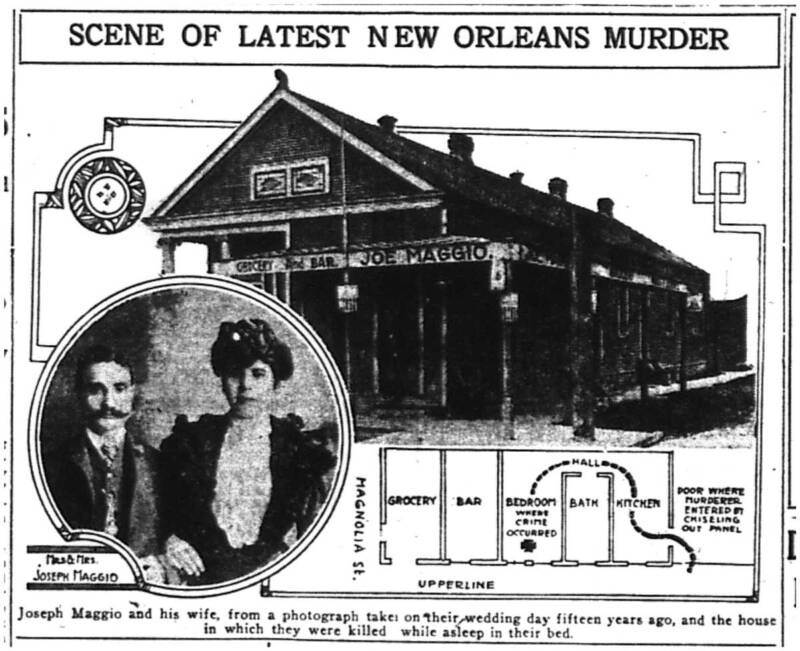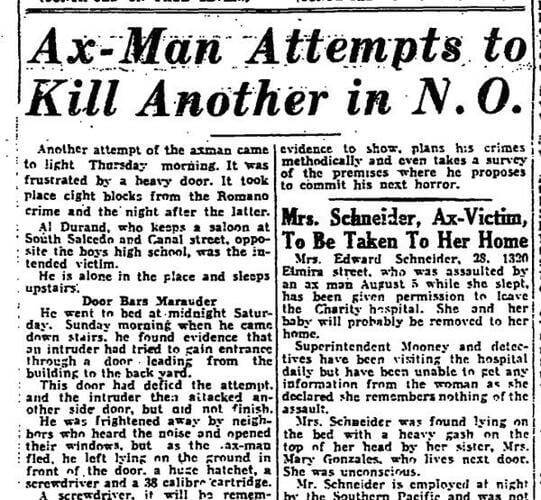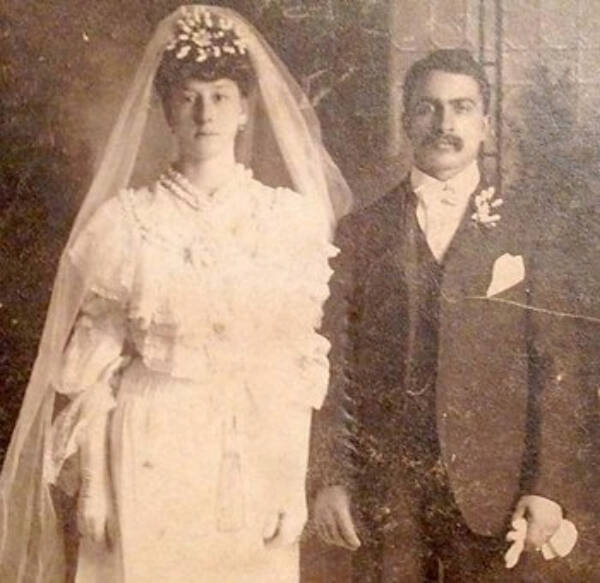In the late 1910s, a mysterious serial killer known as the Axeman of New Orleans terrorized the city, breaking into homes and brutally attacking about a dozen people, often with their own axes.

Public DomainA map detailing the locations of attacks by the Axeman of New Orleans.
On March 18, 1919, the streets of New Orleans were filled with music. People flooded into crowded jazz bars while makeshift jazz bands cropped up in homes across the city, frantically playing into the early hours of the morning without cessation.
Why? It’s what the Axeman requested.
From May 1918 to October 1919, a mysterious serial killer known as the Axeman of New Orleans terrorized the Louisiana city, viciously murdering about half a dozen people and injuring several others. The assailant broke into his victims’ homes in the dead of night by chiseling a panel off of their back doors. Then, he’d creep into their bedrooms and attack them — often with their own axes.
So when a letter supposedly written by the Axeman of New Orleans demanded that the city play jazz music or else face his wrath, New Orleans’ terrified residents obliged. No one was killed on the infamous night of jazz. And to this day, no one knows who was behind the New Orleans Axeman attacks.
The New Orleans Axeman Murders Begin

Public DomainThe home of the Maggios, the first confirmed victims of the Axeman of New Orleans.
On May 23, 1918, an Italian grocer named Joseph Maggio and his wife, Catherine, were viciously attacked while they slept in their Uptown New Orleans home. The assailant entered their room in the middle of the night, slit the couple’s throats with a razor, and hacked them with an ax as they lay in their bed.
Inside the home, which doubled as a grocery store, New Orleans police discovered the bloody clothes of the killer; it appeared that he had changed into fresh clothing before exiting the scene. While the attacker seemed to have taken about $50 from the Maggios, he had left behind other cash and jewelry that had been left out in plain sight, leading police to rule out robbery as his motive.
Investigators also discovered a bloody razor on a neighboring lawn and soon learned that it belonged to Joseph Maggio’s brother, Andrew, who lived next door.
Andrew Maggio, who owned a barber shop nearby, explained to the police that he had recently brought the razor home for repairs. The killer, Andrew suggested, had likely stolen the razor from his property. Andrew had also been the one to discover Joseph and Catherine’s bodies after he allegedly heard the couple moaning through the walls, and police zeroed in on him as the prime suspect.
However, Andrew repeatedly insisted he had nothing to do with the murders, and police could not find any evidence that he was responsible. The case went cold — but the New Orleans Axeman’s bloody rampage was far from over.
The Axeman Of New Orleans Strikes More Grocery Stores

Public DomainA newspaper article about the New Orleans Axeman from August 1918.
On June 27, 1918, another grocer named Louis Besumer and his mistress, Harriet Lowe, were attacked in the apartment connected to Besumer’s store. Besumer had been struck by an ax in his right temple. Lowe, whose injuries were far more severe, was struck over her left ear.
Miraculously, the couple survived the attack, and in the ensuing investigation, Besumer claimed that the Axeman had been a biracial man.
Lowe had a very different story, however. She had been partially paralyzed during the attack, and after undergoing surgery to correct it, she tragically died on Aug. 5, 1918 — but not before she had the chance to (allegedly) set the record straight. While on her deathbed, Lowe claimed her attacker had been none other than Besumer himself.
Besumer served nine months in prison before he was ultimately acquitted of the crimes, with police saying there was not enough evidence to convict him. Once again, investigators had reached a dead end.
The next alleged New Orleans Axeman incident occurred on the night of Aug. 5, 1918, when an unknown assailant attacked a pregnant woman named Anna Schneider in her bed, hitting her over the head repeatedly with a bedside table lamp. Thankfully, Schneider survived and had her baby days later. However, she could not recall any details that might help identify her attacker.
On Aug. 10, 1918, the Axeman of New Orleans attacked a barber named Joseph Romano, brutally bashing him over the head. Romano died from his injuries two days after the attack.
The assailant had abandoned his ax in Romano’s backyard and fled the scene, but not before Romano’s two nieces caught a glimpse of him. According to the girls, he was a large, dark-skinned man dressed in a dark suit and a hat.
On March 10, 1919, the New Orleans Axeman brutally attacked the entire Cortimiglia family in their home in Gretna, Louisiana, a suburb of New Orleans. Both Charles Cortimiglia, a grocer, and his wife Rosie survived, albeit with serious wounds. Tragically, their two-year-old daughter Mary was not so lucky. This murder would launch the Axeman of New Orleans to prominence in the city.

Public DomainMary Cortimiglia was brutally murdered by the Axeman.
“The rumors of him being a demon really ramped up after the Cortimiglia murder,” Luke Siddall, head tour guide and tour manager for French Quarter Phantoms in New Orleans, told All That’s Interesting.
The next attack occurred on Aug. 10, 1919. Steve Boca, also a grocer, was attacked in his home with an ax. He survived the attack, but like Schneider, he couldn’t remember the incident. Then, on Sept. 3 of that same year, 19-year-old Sarah Laumann was attacked with an ax while she slept. She, too, survived the attack.
The last known attack linked to the Axeman of New Orleans came on Oct. 27, 1919. That night, Esther Pepitone awoke to discover that her husband, Mike, had been murdered. She saw the assailant fleeing the scene, but did not get a good look at him.
The Night That The Axeman Forced Jazz Music To Fill The Streets Of New Orleans
On March 16, 1919, only a few days after the attack on the Cortimiglia family, the New Orleans Times-Picayune published a letter they’d received from someone claiming to be the Axeman of New Orleans.
As reported by Country Roads Magazine, in the letter, the Axeman declared that any New Orleans resident who didn’t play jazz music on March 18, the eve of St. Joseph’s Day, would “get the ax.”
“Esteemed Mortal:
“They have never caught me and they never will. They have never seen me, for I am invisible, even as the ether that surrounds your earth. I am not a human being, but a spirit and a fell demon from hottest hell. I am what you Orleanians and your foolish police call the axman.
“When I see fit, I shall come again and claim other victims. I alone know whom they shall be. I shall leave no clue except my bloody ax, besmeared with the blood and brains of he whom I have sent below to keep me company.
“…Now, to be exact, at 12:15 o’clock (earthly time) on next Tuesday night, I am going to pass over New Orleans. In my infinite mercy, I am going to make a little proposition to the people. Here it is:
“I am very fond of jazz music, and I swear by all the devils in the nether regions, that every person shall be spared in whose house a jazz band is in full swing at the time I have just mentioned. If everyone has a jazz band going, well, well then, so much the better for the people. One thing is certain and that is some of those persons who do not jazz it on Tuesday night (if there be any) will get the ax.”

Public DomainSome have suggested that Joseph John Davilla wrote the New Orleans Axeman letter to help publicize his new song.
Panic over the Axeman of New Orleans was such that people took this letter seriously. That night, frenzied music filled the air as terrified New Orleans residents took to jazz clubs or played music in their homes, hoping to keep the Axeman at bay. In the end, no one was killed on this night of jazz — and many have since suggested that the letter was a hoax created by a cruel prankster.
“When you read the letter, this is a person who’s an educated person — he has a classical allusion to Tartarus [the deepest pit of hell in Greek mythology],” historian Miriam Davis told Country Road Magazine. “It reads like it was written by a fraternity or something. And the person who is the Axeman, from the description we’ve got of him, he’s a working man, he’s working class. And I just don’t think a working class person at that time would have been educated enough to write that letter.”
Some even suspect the letter was an elaborate marketing ploy. In the wake of the March 18 scare, a New Orleans jazz musician named Joseph John Davilla released a song called “The Axman’s Jazz (Don’t Scare Me Papa),” claiming he’d written it during the night of jazz. The song was a hit — and some have suggested that Davilla had written the Axeman of New Orleans letter to boost the song’s popularity.
Possible Suspects And Motives Behind The New Orleans Axeman Murders
Part of the reason police had such a hard time catching the New Orleans Axeman was that witnesses to the murders rarely got a good glimpse of the attacker. Some described the Axeman as “dark-skinned,” “large,” or “heavy set,” according to Legends of America. Given this vague profile, authorities were forced to cast a wide net for suspects.
“Once you start digging into the real details of the murders, the axe is ubiquitous, but that is about it. You’re going to have different times, different ways people are getting into the house, whole families are being murdered, then just an individual, different severities, etc. It is far less consistent than the legend makes it,” Siddall told All That’s Interesting.
Investigators questioned dozens of possible culprits, including victims’ neighbors and family members. Even some of the alleged victims themselves were suspected of being the Axeman of New Orleans, as in the case of Louis Besumer. Still, police never uncovered enough evidence to convict anyone of the murders. The Axeman remained at large.
Over the years, a number of theories have emerged as to why the Axeman of New Orleans turned to murder in the first place.
One theory suggests that the attacks were racially motivated, given that the New Orleans Axeman appeared to be targeting Italian grocers and their families. Others have suggested that the attacks were Mafia-related.
“My theory is that the mob was shaking down these Italian grocers for protection money and a lot of them were refusing. They started directing all of their enforcers to ‘do it like this – people won’t think it’s the mob, they’ll think it’s this killer,'” Siddall told All That’s Interesting.
However, some contemporary researchers believe the Axeman of New Orleans could have been a man named Joseph Mumfre.

Public DomainMike and Esther Pepitone, the former a victim of the New Orleans Axeman.
In 1907, long before the attacks, Mumfre had reportedly been arrested for trying to bomb an Italian grocery and was incarcerated between 1911 and 1918.
According to some researchers, after Mike Pepitone’s murder, his widow, Esther, remarried a man who was reportedly in business with Mumfre, and moved with her new husband to Los Angeles.
Soon after, however, Esther’s second husband mysteriously disappeared; Mumfre then reportedly entered Esther’s home and tried to rob her at gunpoint, threatening to kill her “like I did your husband.” Instead, Esther managed to reach for her own gun and kill Mumfre first. Later, she told authorities that she recognized Mumfre as the man who had killed her first husband.
Among locals, Mumfre is believed to have been connected to the mob in New Orleans. A string of similar murders were committed in 1911, sparking locals to believe that Mumfre may have started prior to his incarceration and then picked up where he left off when he was released.
“I think Mumfre was the first guy to do it. Once he gets out of jail in 1918, his rank moves up [in the mob] and he starts teaching other guys how to do it,” Siddall explained.
But despite this apparent connection to the case, no one has ever been able to find concrete evidence that Mumfre was the New Orleans Axeman. To this day, the serial killer or killers’ identity remains a mystery.
While the case has gone cold, the story of the Axeman of New Orleans is certainly not forgotten. The jazz-loving killer continues to haunt popular culture to this day, appearing as a character in hit television shows like American Horror Story: Coven and The Originals.
After this look at the Axeman of New Orleans, meet seven suspects who may have been responsible for Jack the Ripper’s grisly crimes. Then, read about another legendary New Orleans resident, voodoo queen Marie Laveau.





